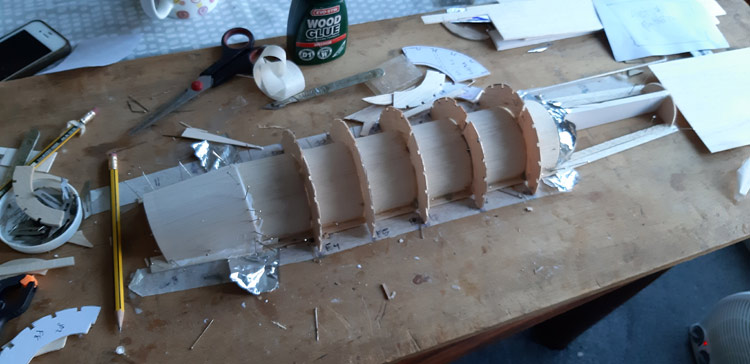
It’s no use. I’ve done it again… I’ve started a new project even before my latest Boulton Paul P111 plane is test flown! I don’t know; it’s like a bad habit or something. i just can’t help it! I blame Hippocket Aeronautics. That forum is just too inspiring!
You see there’s so much free flight duct fan action on there -as well as a ton of other stuff- which is all really, really good. And the thread writers who are involved with that genre have a lot of experience and interesting anecdotes that they put on the site, it makes it irresistible not to become more involved and so make more stuff!
So with that said, and based upon what they were doing, I decided to design a new, smaller ducted fan model based around the infamous Cox 049 engine. This is the Saab J29 Tunnan. It’s a great looking and porky shaped aircraft. With the experience that I gained from designing the Boulton Paul, as well as recognizing some of the glaring mistakes I made, designing the Saab has been easier, and a little quicker.
Number one thing I was determined to do is to design it light. We’re dealing with a small engine after all. So the duct itself, as you will see is made from the softest, lightest 1/32″ balsa I could find. The former’s, initially to be soft 1/8″ balsa is now 1/16″ (though I may go back to 1/8″ as it is easier to handle) with hard balsa only used to the fuselage keels. What I did first though was build a framework to form the ducting on. This consisted of 1/8″ sheet balsa half former’s and 1/8″x 1/4″ balsa strips. The whole assembly once cut out was glued together and pinned down onto the building board. Check out the pics below 🙂

sheet balsa half formers to build the framework

framework former’s cut out then sanded to shape

glued together framework
Once I was ready to start forming the duct shapes, I covered the half formers with cut strips of mylar to stop the sheet sticking to it.

mylar tape on top of the former’s
On one of the Hippocket build threads the builder used molded balsa panels to form the ducting on his duct fan model. I did the same but it took a few attempts to get the right.
First time round I covered the cut balsa panels with lightweight tissue doped on, but as it dried, they quickly curled up into a tube! When I tried to unwind one of them to place on the mold the sheet just split.

Several mistakes later and I finally managed to to complete the ducting, although I still ended up with a split in one half of it. In the end what I did was just heat the sheet panels over the gas cooker and bent them to the shape I wanted. Then place them quickly over the mold frame and pin in place and it seemed to work. Check out the pictures below 🙂

Here’s the rear half-cone duct shape paper template placed on the doped duct sheet ready to be cut out. Notice the curve already? Also notice the split in the pinned down sheet duct for the upper fuselage.

here it is. quite a split in the duct! – this will be repaired later

here’s the lower half duct, with the front part of the duct glued and pinned down. Also some of the notched former’s are glued in place

..and here’s the rear section being prepped for the curved sheeting which is already made
It took quite a while to build the two duct pieces during my spare time. They just seemed really fiddly and time consuming, which I wasn’t expecting. I then started on the fuselage former’s. I drew them at 1/8″ thick balsa, but then decided to make them from soft 1/16″. Doh!! what a mistake that was. I kept smacking them with my hand when building and often split them! If i decide to make the model again they’ll definitely be from soft 1/8″ sheet.

completed fuselage halves. lower one in the pic still has the framework inside, which I just need to pop out. Top one – you can see the accidental split in the former

top view. The first lower keel had been added. Next will be the 1/8″ square stringers.

and here’s the engine platform, cut from 1/8″ thick ply. It will be cut out and drilled for a Cox Tee Dee motor, although a Sure Start motor out is printed on the paper template
The model is designed to take a Cox Sure Start motor, as I’ve got a few of them and they’re pretty cheap to buy. But recently I managed to get a Cox Tee Dee 051 engine on eBay for a very reasonable price, so I’m super-stoked! I decided in the end to use that one.
So far so good. Both fuselage halves are very light with the soft balsa ducting and former’s in place. There will be a slight weight increase when I add the plywood engine plate and wing mount piece and all the other bits and pieces, but I’m going to strive hard to keep the all up weight down.
I gotta confess, there has to be a simpler way of building a fuselage like this , since this was way more difficult than the Boulton Paul. What do you think? See you next time 🙂
